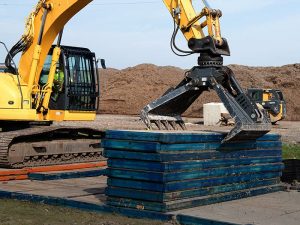If you work in power transmission and distribution, pipeline, construction, civil engineering or other industries that require ground protection mats or site access, you know that not all jobs — or job sites — are the same. Project duration, maintenance, weather, or other delays can be unpredictable.
The good news is that most ground protection providers offer flexible rent, lease, or buy options. However, each path has its own benefits or drawbacks, and not all providers are the same. Making the right choice can save you time, money, and some headaches as you work toward your goal: a successfully completed project.
First Step – Assess Your Project Duration
The duration of your project is one of the most important considerations in making the right choice to rent, lease, or buy. That’s because most ground protection providers charge a daily rate for renting, or a set amount for a pre-determined lease period. You may be charged additional costs depending on your provider’s policies if you extend beyond your lease period or return mats that are severely damaged.
Renting Vs. Leasing
In general, renting with a daily rate is the best option for shorter projects — a few weeks up to a few months. For projects that will run anywhere from a few months to 12-18 months, leasing might be the more economical choice. Most providers will establish a lease for a set term (with freight included) at a lower rate than renting. This prevents you from accruing daily charges that add up quickly.
Buying and Selling Back
If you are working on a lengthier project with more projects to come; then consider buying your mats to get more long-term value from your matting budget. Most ground protection providers will offer you the option to sell back your mats — even if they’re from another manufacturer or provider. Having the option of selling your mats back to a ground protection provider may help reduce your overall cost.
Keep in mind that once you own your mats, you’ll be responsible for logistics and moving, storage, maintenance, and repairs.
Other Considerations
When you’re assessing project duration and renting or leasing, don’t forget to consider weather factors and potential obstacles, such as a blackout during a transmission line project. Think about whether you’ll need to move mats around the site or store them in between project phases — this possibility might alter your timeline.
Depending on job site conditions or equipment, mats might become damaged and require cleaning. If you lease, this might incur more costs beyond a negotiated attrition rate.